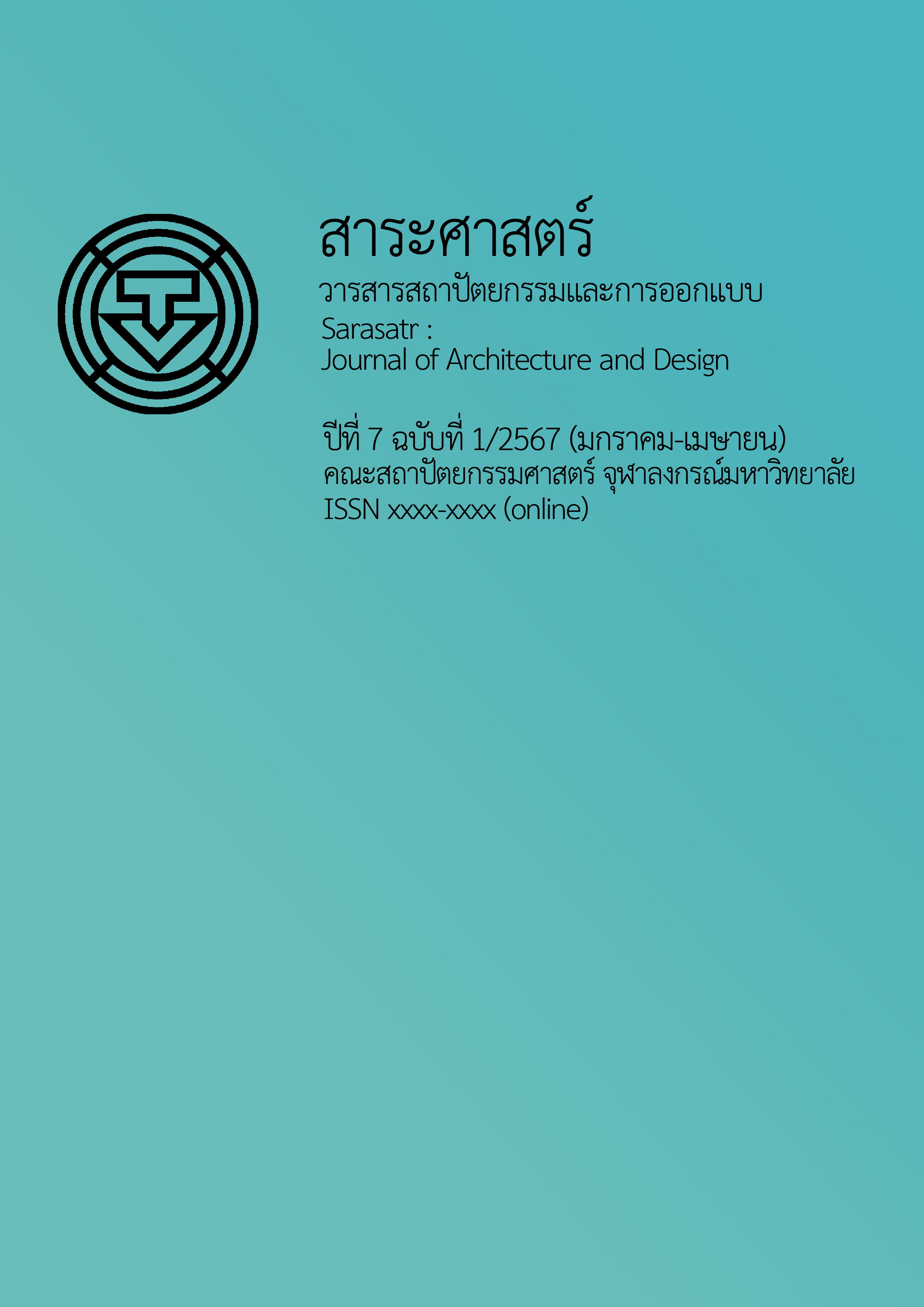Energy Daylight Efficiency of Aerogel Skylights in Warehouses Building according to Spatial Daylight Autonomy (sDA)
Main Article Content
Abstract
The use of lighting energy for warehouse operations is one of the problems of energy use in warehouse buildings. Current warehouse designs still do not fully utilize the efficiency of natural light. This is because the use of natural light during the day that shines through the translucent panels on the roof will create heat inside the building and affect the higher cooling energy usage in the case of a temperature-controlled warehouse building.
This research studied a warehouse building with a size of 23,200 square meters and a height of 10.00 m as a case study. It presents design guidelines to increase the efficiency of bringing in natural light to reduce the use of electrical energy, lighting and cooling energy within the warehouse. and evaluate with Definition Spatial Daylight Autonomy (SDA) according to LEED V4 criteria, Daylight topic, using the Design Builder program to help simulate the results, which has the variables: U-Value, Visible light transmittance (VLT), Skylight roof ratio (SRR), and Solar Heat Gain Coefficient (SHGC).
The the study it was found that Warehouse building that uses air gel sheets (Paneri et al., 2019) can help pass the 55% sDA criteria must use an SRR area that is not less than 5%. Transparent fiberglass sheets that are commonly used must use an SRR area that is not Less than 25% will be able to pass the 55% sDA criteria. It can be seen that using the roof area proportion between 5%-15% has a clearly different effect on light reception. In terms of total energy use, using translucent airgel sheets can help reduce total energy by 19% per year. However, using translucent light to help save electricity and artificial lighting can help reduce it by only 3% per year. Therefore, consideration must be given to the appropriateness of choosing each type of translucent sheet. However, taking advantage of natural light must depend on the daily environment as well as the type of building. This will create efficiency in using natural light to suit each type of building.
Article Details
References
ทรงพล อัตถากร. (2563). การเปิดรับแสงธรรมชาติในโถงกึ่งเปิดโล่งเพื่อความยั่งยืน : กรณีศึกษา อาคารสถานศึกษาย่านชานเมือง กรุงเทพมหานคร. วารสารวิชาการคณะสถาปัตยกรรมศาสตร์และการผังเมือง มหาวิทยาลัยธรรมศาสตร์, 18(1), 153-169. https://www.researchgate.net
นาโนเทค. (2554). Aerogel วัสดุของแข็งที่เบาและเป็นฉนวนที่ดีที่สุดในโลก. https://www.scimath.org/article-science/item/2117-aerogel
ปิยะนุช สถาพงศ์ภักดี. (2565, กุมภาพันธ์). แนวโน้มธุรกิจ/อุตสาหกรรมปี 2565-2567 : ธุรกิจคลังสินค้า. วิจัยกรุงศรี. https://www.krungsri.com/getmedia/023107a0-2e43-4f66-b1b4-d09f5e896070/IO_Warehouse_220211TH_EX.pdf.aspx
รุจิเรจ อินทรเนตร. (2558). การออกแบบแผงบังแดดเพื่อได้แสงธรรมชาติและประสิทธิภาพด้านพลังงานในอาคารตามเกณฑ์การประเมินอาคารเขียว วี4 (LEEDv4)[วิทยานิพนธ์ปริญญามหาบัณฑิต, จุฬาลงกรณ์มหาวิทยาลัย]. Chulalongkorn University Intellectual Repository. http://cuir.car.chula.ac.th/handle/123456789/51134
ศิรวิชญ์ รงควิลิต. (2561). การประเมินประสิทธิภาพแสงธรรมชาติและการใช้พลังงาน จากการออกแบบหิ้งสะท้อนแสงในอาคารสำนักงาน ตามเกณฑ์การประเมินอาคารเขียว ลีด เวอร์ชัน 4.0 [วิทยานิพนธ์ปริญญามหาบัณฑิต, จุฬาลงกรณ์มหาวิทยาลัย]. Chulalongkorn University Intellectual Repository. https://cuir.car.chula.ac.th/handle/123456789/82747
อวิรุทธ์ ศรีสุธาพรรณ. (2557). ศักยภาพการลดการใช้พลังงานจากการใช้แสงธรรมชาติตามกฎกระทรวง. วารสารวิจัยและสาระสถาปัตยกรรม/การผังเมือง, 11(2), 37-52. https://www.researchgate.net
อวิรุทธ์ ศรีสุธาพรรณ. (2563). แนวทางและการประยุกต์ใช้ตัวชี้วัดแสงธรรมชาติสำหรับอาคารในประเทศไทย. วารสารวิจัยและสาระสถาปัตยกรรม/การผังเมือง, 17(1), 103-119. https://www.researchgate.net DOI: 10.14456
Alexander, M. (2019). 5 ways to reduce energy costs for your industrial space. https://www.loopnet.com/learn/5-ways-to-reduce-energy-costs-for-your-industrial-space/186058888
Huang, Y., & Niu, J. (2015, September). Energy and visual performance of the silica aerogel glazing system, in commercial buildings of Hong Kong. Construction and Building Materials, 94, 57-72. https://www.sciencedirect.com/science/article/pii/S095006181530009X
Paneri, A., Wong, I. L., & Burek, S. (2019). Transparent insulation materials: An overview on past, present, and future developments.Solar Energy, 184, 59-83. https://www.sciencedirect.com/science/article/pii/S0038092X19303196
U.S. Green Building Council. (2021). LEED v4.1. daylight indoor environmental quality. https://www.usgbc.org/credits/new-construction-schools-new-construction-retail-new-construction-datacenters


